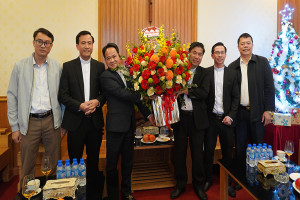
For Khmer people, the sala in each pagoda is traditionally a kind of meeting place for Buddhists, the preaching hall for monks, and the venue for receiving visitors to the pagoda during the Traditional New Year and traditional events.
The sala is the second most important construction in Khmer pagodas, after the sanctum or the main worshipping hall. It’s traditionally a wooden structure erected on a platform from one meter to 1.5 meters in height and with a large floor. It boldly features the architecture of the Khmer and Theravada Buddhist culture and decorations with carved reliefs depicting Buddhist stories inside and carvings of dragon figures on the roof.
The sala floor is often divided into functioning areas of different sizes and suiting different purposes. In the middle of the sala is the altar dedicating to Buddha Shakyamuni but simpler than the altar in the main worshipping hall.
Beside Buddhist functions, the sala has served as the cultural and communal center for the local Khmer village. It is the place holding Khmer cultural activities and the venue for gatherings to discuss and solve important village issues.
Many Khmer pagodas have well preserved its wooden sala, including pagodas of Kh’leang and Luong Bassac Bai Xau in Soc Trang province, Xiem Can and Cai Gia Chot in Bac Lieu province, Ang and Hang in Tra Vinh province, etc.
According to Ven. Dương Quân, Head of Xiem Can Pagoga located in Bac Lieu city, the sala’s active role in preserving Khmer traditions has created an deep impression on Khmer Buddhists.
There have been more changes to the building structure and the use of the sala in many Khmer pagodas since the modern time. Some of new salas’ structure has been erected with the steel and concrete.
In addition to traditional functions serving as venues for Buddhist preaching and practices, more cultural activities including Apsara dancing and the traditional five-tone music performance for tourists have taken place. It’s also the place for monks to take daily meals or receive distinguished guests, and for Buddhists to organize Buddhist rites and make offerings to monks, etc.
As the place where monks and the Khmer people gather to prepare for important ceremonies, the sala in Khmer pagodas has become a space of communal activities and cultural traditions of the Khmer people, contributing to preserve the beautiful features of Khmer architecture, and cultural identities of Khmer villages.
PTT




